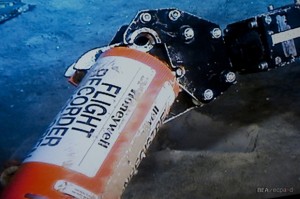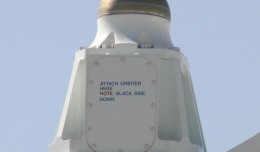Imagine the force of driving your car into a brick wall at 120 miles an hour. Now imagine instead of being in a car, you are strapped into an Airbus A330 that is descending vertically (I do not like the term “falling” in referring to aviation incidents) at 120 miles an hour into the Atlantic Ocean. Air France Flight 447 at its point of impact off the coast of Brazil was descending at over 10,000 feet per minute, or, roughly two miles per minute, an unbelievably high rate of descent that unfortunately is only seen in one type of scenario. A grim one.

Hoisting the tail from AF447 aboard a ship during recovery.
The tragedy of Air France Flight 447 is one that will be remembered for a very long time. In this article I will attempt to provide some insight into what I have gleaned from the most recent investigation reports of the accident. I am by no means an air accident investigator, nor can any of my comments be taken as fact. This is merely my professional opinion as to what may have occurred on the night of June 1st, 2009 and the myriad questions that have resulted in my mind after having read the Investigation Update.
Obviously this accident was a terrible tragedy not just for the people on board, but the families, companies, and even the search and rescue crew hoping to find signs that anyone had survived the crash. I remember thinking selfishly to myself the evening that the accident happened that despite the horrific nature of the events, that they needed to be able to recover the black boxes, also known as the Cockpit Voice Recorder (CVR) and Flight Data Recorder (FDR). I say selfishly because as a cockpit crewmember I have a vested interest in learning from every accident out there. In this case, a heavyweight, wide-bodied airliner, traversing an area of strong weather had just “disappeared”. My airline operates that same type of aircraft through similar conditions so I wanted to know how it could be avoided. Without the Black Boxes though, it would be tough to pinpoint the cause. I had a lot of questions going through my mind. What had happened? How could it happen? Why did it happen? Without the CVR and FDR, it would just be lip service and guess work to try to put the pieces together.
On May 1st of this year, after almost two years of on and off searching, the FDR was located in the depths of the Atlantic Ocean. Although this was a tragic accident, my selfish needs were satisfied–as were those of thousands of other aircrew members. I only hoped that the information would be recoverable after almost two years underwater. My hope was that we could learn from this so that the passengers and flight crew would not have died in vain that terrible night over the Atlantic Ocean.
This past Friday morning, an Investigation Update from AF447 was released by the Bureau d’Enquetes et d’Analysis pour la securite de l’aviation civile. This report is very similar to the preliminary report the FAA would issue in a similar accident. It is quite an interesting read, and frankly is relatively similar to what most people had suspected happened onboard that evening. The general consensus was that the aircraft had had a problem with instrumentation possibly due to icing at altitude and the result was that some sort of loss of control occurred resulting in the crash. The only problem was that this was all guesswork.
I must be clear here that this is still very much a rough guide to the accident and not the final report. I also must make it clear again that I am only giving my personal opinion on the accident and it must not be construed as fact. I think after having read the report, I am left with only more questions. The final report will be the only definitive source as to what actually happened that night.
What we do know is that on the night the accident occurred, the aircraft traversed an area of heavy thunderstorms called the Intertropical Convergence Zone (ITCZ). I’m not going to get into specifics of the origins of the ITCZ, but for the sake of this article, all we need to know is that it is very common to have huge areas of storms in this part of the world.
We now know that in the minutes before the accident, the aircraft deviated from its planned heading. Although, the report does not indicate exactly why, I can only infer that it was due to the avoidance of weather (precipitation returns on the radar are typically avoided due to potential turbulence and ice depending on the strength of the return). In some cases, despite a flight crew’s best intention to avoid such areas of weather, the aircraft will penetrate some of it.
My guess is that on the night in question, such an inadvertent penetration of weather occurred. One common element of upper level atmospheric conditions in these types of thunderstorms are super-cooled water droplets. These are droplets of water that are in liquid form until the instant they come in contact with anything at which point they immediately freeze. The build up of ice due to super-cooled water droplets happens almost in an instant when flying through them. The best course of action is to exit this area of moisture as it is generally quite localized.
The problem with ice building up on an airplane is the negative effect it can have on the aerodynamics of the wings and tail, as well as the effect it can have on the instruments that depend on ram and static air sources during flight, namely the airspeed indicators, vertical speed indicators, and altimeters. Because these are such critical instruments, the sources, as well as the wings, are heated to prevent ice build up. As the accident regarding AF447 revolves around airspeed fluctuation, I will focus on the equipment responsible for airspeed readouts, otherwise known as the pitot tube.
On the airplane I fly (the Boeing 747-400) the pitot tubes are heated automatically once an engine is running. This is to prevent ice buildup so as to allow a smooth flow air directly into the tube. The airplane’s computers compare this moving, or “ram” air, to the “static” or still air and convert the indication to the indicated airspeed we read on the airspeed indicator. On other modern airline designs, there are sometimes switches that control the heaters, but for almost all intents and purposes, anytime an airliner is in the air, the pitot heat is on.

I have no doubt that the pitot heat was on onboard Flight 447. But there is a question that I have. What happens if the ice buildup is so rapid, the pitot heat cannot cope with the situation? I have a feeling this is what may have been a factor in the beginning of the end of AF447. Could the aircraft have inadvertently entered an area of precipitation with super-cooled water droplets so intense that the pitot heat on all three sensors on the A330 (yes, the A330 has three pitot tubes) could not keep up?
What leads me to believe this is that according to the report at 2:10:05, the autopilot and autothrust disconnected and the airspeed went from 275KIAS to 60KIAS very quickly. They received stall warnings appropriately as the aircraft thought it was stalling based on the airspeed indications. Why did the automation kick off? In most modern jets, some times severe turbulence will exceed the capabilities of the autopilot resulting in it disconnecting. Thunderstorm cells are ripe with turbulence. In addition, it is not uncommon to get very large (20 knots or more) speed excursions from the cruise speed in these types of conditions. Could the aircraft have entered a cell with severe turbulence resulting in the automatics kicking off? Does a stall warning automatically disconnect the automation in an A330? Possibly, but I do not know. What I do know is that a drop in airspeed from 275 to 60 instantly is almost unheard of. What is likely is that in the cell were super-cooled water droplets that inundated the heating element of the pitot tubes to the point that ice starved the Pitot Tubes of ram air giving an almost instant massive decaying of indicated airspeed.
Now as this all was occurring the aircraft had begun a climb due to the pilot flying (PF) giving the sidestick a nose-up input after the autopilot disconnected. The problem we have here though is that we don’t know if it was a small or very large input. The crew could have been momentarily distracted by the automation disconnecting, the warning horns and ECAM indications going off, the turbulence, the airspeed excursion, the heading diversion, the potential lightning (my imagination at work), that it is entirely possible that there was an inadvertent nose-up attitude established in the heat of the moment. All I know is that there was an awful lot of visual and auditory stimulation going on in that time and it is very possible that the aircraft entered a slow climb at the point. At high speeds, it doesn’t take a large pitch change to result in a very fast change in rate of climb.

Pitot tubes on an Aribus A330.
Only 11 seconds later, the Angle of Attack was at 10 degrees nose up and increasing, and the speed according to the report, “increased to 215KIAS” on the Captain’s side. I do not believe for a minute that the aircraft went from 275 to 60 to 215KIAS. What I do believe is that the aircraft entered a gradual climb after the initial disconnect of the autopilot. As we know, when we climb in an aircraft without adding power the airspeed drops. In this case, I believe it took those 11 seconds for the heating element on the pitot tube to melt the ice that had accumulated on it. So essentially, the aircraft entered a climb at 275KIAS, and after 11 seconds, the angle of attack had increased to above 10 degrees resulting in the speed decaying to 215KIAS. At that point the angle of attack was only four degrees.
About 35 seconds later, there was another stall warning. I believe this to be the first accurate stall warning. Now why did the aircraft stall? One theory I have is based on the fact that the airspeed indicator on the left was working again. Was the right indicator operating? We do not know as the FDR doesn’t have that info. I bring this up because at my carrier, when the Captain is on rest, the relief qualified First Officer (FO) sits in the seat in which he normally operates. So when I am the relief FO, I am always the PF and I always stay in the right seat. Is it possible Air France does the relief duty the same way? I do not know but perhaps it is possible that the PF on AF447 was in the right seat needing to look at the Captain’s PFD to get accurate airspeed indications. Maybe the PF thought, “OK, I have this under control now with pitch and thrust,” but did not have the spare capacity at the moment to look across the cockpit to see the other Captain’s airspeed indicator slowly bleeding off. I do not know and I do not cast judgment. Only more questions. Oh my.
One topic the media loves to talk about is that the PF appears to have continually given nose-up inputs throughout this event. We know now that the attitude of the aircraft was increasing almost the entire time. Is it possible though that those inputs were correct for that aircraft in that state of flight? Obviously in any typical airplane, in a stall you release back pressure and lower the nose, break the stall and recover. An Airbus is no typical airplane, though. There are times when you can haul all the way back on the sidestick and not only not enter a stall but fly at an optimum rate of descent. Anyone here heard of Chesley Sullenberger? He did exactly that on January 15, 2009 when he greased an A320 into the Hudson River. Is it possible that the PF on AF447 possibly thought he was going to be flying at an optimum flight profile by increasing back pressure on the side stick? I am by no means an Airbus pilot so I hope one chimes in, but what I do know is that there are Normal and Direct Laws, and the flight controls do very different things depending on which Law you are operating in. Is it possible that in the heat of the moment there may have been confusion as to what Law they were operating in?
Finally, 49 seconds after the second stall warning, the Captain entered the cockpit, but it was probably too late. At that point the aircraft was pitched up to 16 degrees, descending at over 10,000 FPM, with an angle of attack of more than 40 degrees. That gave the aircraft a 24 degree descent profile. A typical airliner descends on a three degree profile. This was steep, unbelievably so. At this point, the airspeed indications once again became invalid due to the low amount of ram air entering the pitot tubes straight on. The air that was entering the pitot tubes was striking them not only at a low airspeed, but also at an angle of over 40 degrees.
A point I would like to make here is that it took one minute and thirty five seconds to go from cruise speed (275KIAS) to a deep potentially unrecoverable stall. When confronted with all of the potential distractions this is a rather insidious decaying of airspeed. It is not as if this aircraft had slammed on the brakes. Yes, they did lose about 60 knots in the first 11 seconds, but it appeared as though the pilots may have thought they had managed the situation at that point. They lost speed quite slowly for the remainder of the event. They lost on average one knot every two seconds after the initial large pitch up. That is not an overly large deceleration. Could it have been possible that this crept up on them very slowly and gradually? Maybe. It is just one more piece to the puzzle.

A body recovered from AF447 is removed from a helicopter for identification.
Finally the final question must be asked. Was this pilot error? The media, the world, and especially the lawyers are salivating over the answer to this question. The answer is…we just do not know. There are so many questions that need to be answered we cannot make an honest answer yet. Were the systems flawed, was there a poor design in the pitot tubes as has been suggested, was the automation not operating correctly, etc, etc.
One thing this report does not include is the entire cockpit conversation. From reading this, it looks like hardly anything was said at all. I for one suspect there was a lot more conversation than we are being privy to here. I also suspect there is a lot more information from the flight data recorders that we have not been given. Once again this is an “Investigation Update”, not a final report.
What I can say though, is that I cannot imagine what was going in the heads of the pilots as this was unfolding, especially as they must have at some point realized they were in an unrecoverable deep stall. What do you think when you know you are going to die? Do you think this is possible? Do you think you are dreaming? Do you panic? I do not know nor do I hope to ever find out. That is why this crew will not have died in vain, but rather by their own demise they will hopefully prevent another accident like this from ever happening again. Morbid? Yes. Horrible? Yes. But true. We learn not only from our own mistakes but from the actions of those that have not been as fortunate. As terrible as this accident was, we will as an industry be safer once the final report is out and we implement what we have learned from this tragic events into our everyday operations. It cannot happen soon enough.
NYCAviation Columnist Justin Schlechter is a First Officer for an international airline and lives with his family on Long Island, New York. You can read more of his writing on his Positive Rate blog.








